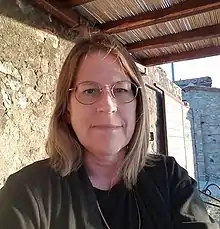
Sarah L. Pallas is an American neuroscientist and a Professor of biology at the University of Massachusetts Amherst.[1] She is a fellow of the American Association for the Advancement of Sciences (AAAS)[2] known for her cross-modal plasticity work and map compression studies in the visual and auditory cortical pathways.[3]
Background and education
Sarah Pallas was born in Minnesota.[3] Pallas completed her undergraduate education at the University of Minnesota and graduated with a B.S. in biology. From there, she attended Iowa State University to obtain a master's degree in Zoology. For her Ph.D. she studied developmental plasticity in Ronald R. Hoy's and in Barbara L. Finlay's lab at Cornell University.[3] Pallas completed her postdoctoral training at the Massachusetts Institute of Technology in Mriganka Sur’s lab in the Brain and Cognitive Sciences department.[3] She started her own lab in 1992 at Baylor College of Medicine and moved to Georgia State University in 1997 along with her husband Paul Katz.[4] Pallas was promoted to Full Professor in 2006 and was appointed a Fellow of the American Association for the Advancement of Sciences (AAAS).[5]
As of 2019, Pallas is an Associate Professor of Biology at the University of Massachusetts Amherst and runs her own lab studying neural development and plasticity in auditory and visual pathways.[1] Her lab functions under the Neuroscience and Behavior Molecular and Cellular Biology Graduate Programs in the University of Massachusetts Amherst's Biology Department.[6]
Career
In her scientific career, Sarah Pallas has worked on a variety of projects in understanding the mechanisms behind neural development and plasticity. Her prior work includes cross-modal plasticity of visual and auditory inputs in ferrets.[7][8] In addition, Pallas has also worked on topographic map compression in the superior colliculus (SC).[3]
Awards and honors
During her postdoctoral training at M.I.T., Pallas was awarded a NRSA fellowship from the National Health Institute and National Eye Institute.[3] In 2005, she received the Evolution Education Award by the National Association of Biology Teachers while working at Georgia State University.[5] In addition, Pallas was appointed as a fellow of the American Association for the Advancement of Sciences (AAAS) in 2012.[2] Most recently, Pallas received the Alumni Achievement Award in 2020 from her alma mater, University of Minnesota.[9] Lastly, Pallas was awarded tenure in 2020 from the University of Massachusetts Amherst.[10]
References
- 1 2 "UMass Amherst: Biology Department: Faculty: Sarah Pallas". www.bio.umass.edu. Retrieved 2021-04-26.
- 1 2 "AAAS Members Elected as Fellows | American Association for the Advancement of Science". www.aaas.org. Retrieved 2021-04-28.
- 1 2 3 4 5 6 "Episode 03: Sarah Pallas, PhD". Conjugate: Illustration and Science Blog. Retrieved 2021-04-26.
- ↑ Katz, Paul (March 21, 2006). "Paul Katz". Current Biology. 16 (6): R190–R191. doi:10.1016/j.cub.2006.02.033. ISSN 0960-9822. PMID 16586566.
- 1 2 "Sarah Pallas". College of Arts & Sciences. Retrieved 2021-04-28.
- ↑ "Pallas Lab Website". sites.google.com. Retrieved 2021-04-28.
- ↑ von Melchner, Laurie; Pallas, Sarah L.; Sur, Mriganka (April 2000). "Visual behaviour mediated by retinal projections directed to the auditory pathway". Nature. 404 (6780): 871–876. Bibcode:2000Natur.404..871V. doi:10.1038/35009102. ISSN 1476-4687. PMID 10786793. S2CID 4428568.
- ↑ Mudd, David B.; Balmer, Timothy S.; Kim, So Yeon; Machhour, Noura; Pallas, Sarah L. (2019-06-05). "TrkB Activation during a Critical Period Mimics the Protective Effects of Early Visual Experience on Perception and the Stability of Receptive Fields in Adult Superior Colliculus". Journal of Neuroscience. 39 (23): 4475–4488. doi:10.1523/JNEUROSCI.2598-18.2019. ISSN 0270-6474. PMC 6554622. PMID 30940716.
- ↑ "CBS Alumni Awards | College of Biological Sciences". cbs.umn.edu. Retrieved 2021-04-28.
- ↑ "Three Women Scholars Awarded Tenure at the University of Massachusetts Amherst". Women In Academia Report. 2020-04-30. Retrieved 2021-05-03.